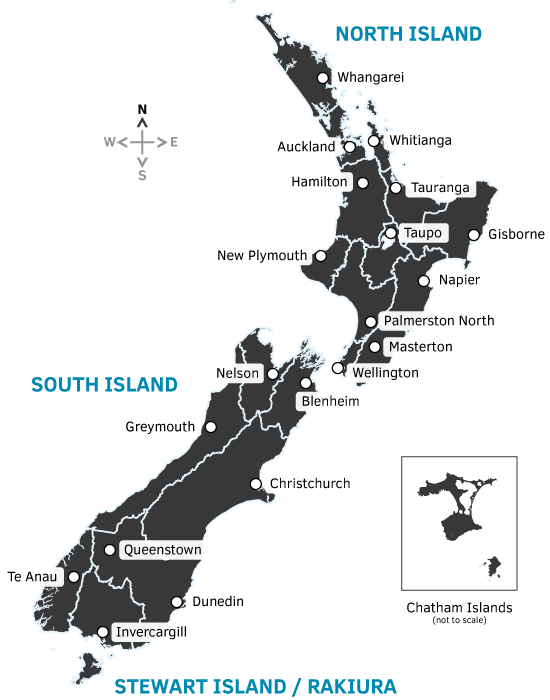About New Zealand
Geography
New Zealand stretches 1600km from north to south. It consists of 2 main islands and some smaller islands, and several far-flung islands several hundreds of kilometers away. Stewart Island lies directly south of the South Island. The country is 10,400km southwest of the USA, 1700km south of Fiji and 2250km east of Australia. NZ's total area is greater than that of the UK, but almost 36 times smaller than that of the USA. Its coastline, with many bays, harbours and fiords, is long compared with its landmass. A notable feature of NZ's geography is the great number of rivers. There's a lot of rainfall in NZ and that has to go somewhere. The Waikato river is the country's longest river in the country. New Zealand also has many beautiful lakes. Lake Taupo is the largest, Waikeremoana and Wanaka are two of the most beautiful.
Population and People
As of June 2016, the population of New Zealand is estimated at 4.69 million and is increasing at a rate of approximately 2.1% per year. New Zealand is a predominantly urban country, with 73.0% of the population living in the seventeen main urban areas (i.e. population 30,000 or greater) and 53.7% living in the four largest cities of Auckland, Christchurch, Wellington, and Hamilton.
New Zealand cities generally rank highly on international livability measures. For instance, in 2016 Wellington was ranked the world's most liveable city.
Of New Zealand's population, 74% are NZ European (NZ pakeha), 14% are NZ Maori, 6% are Pacific Island Polynesians and about 6% are Asian.
Climate and Weather
Lying between 34S and 47S, New Zealand is in the Roaring Fourties. It has a temperate climate with mild temperatures, and a prevailing wind blows over it from west to east year-round, ranging from gentle, freshening breezes to occasional raging gales in winter. Coming across the Tasman Sea, this breeze is relatively warm and moisture-laden. When the south wind comes up from Antarctica it means cold weather.
In the South Island, the mountains act as a barrier for the winds coming across the Tasman Sea, creating a wet climate on the west side of the mountains and a dry climate on the east side. In the North Island, the western sides of the high volcanoes get a lot more rain than the eastern sides, but the rain shadow is not so pronounced, as there is not such a complete barrier as the Southern Alps.
New Zealand receives plenty of sunshine hours throughout the year, but being a maritime climate, the weather is very changeable. Temperatures range from around 25-28 degrees C in summer and 10-15 degrees C in winter. It may get frosty at night, and needless to say that the Southern Alps get snow in winter.
Language
English and Maori and both the official languages of New Zealand. English is spoken by just about everyone in NZ, however Maori is the language of everyday conversation in a very small number of rural areas, particularly in Northland or the East Coast. Polynesian languages may be heard in Auckland and Wellington.
National Parks
New Zealand has 13 different national parks which are administered by the Department of Conservation. A good resource for more information about the national parks of New Zealand can be found here.
Fauna and Flora
As is the case for most Pacific islands, New Zealand's native flora and fauna are for the most part endemic. Here you'll find the world's largest flightless parrot (kakapo), the only true alpine parrot (kea), the oldest reptile (tuaara), the smallest bats, some of the oldest trees, and many of the rarest birds, insects and plants in the world.
With no large native land mammals, birds dominate NZ's fauna. There is not an enormous variety of bird life in NZ, but there are some remarkable, strange specimens about! In such a peaceful, uncompetitive environment, flightless birds such as ground-dwelling kakapo, kiwi and weka not only survived but thrived.
Perhaps one of the greatest delights of a trip to NZ, especially in the South Island, is a chance to observe the wealth of marine mammals. There are 76 species of whales and dolphins on this globe and NZ, as small as it is, is blessed with 35 of these species. Kaikoura, north of Christchurch, is particularly blessed, as nearly half of that number of whales and dolphins have been seen in waters of its shores.
More articles to help you plan your New Zealand holiday
Facts for the New Zealand visitor
New Zealand Touring Itineraries
Facts for hiking in New Zealand
Traveling around New Zealand in a motorhome
Best time to visit New Zealand
Best places to visit in New Zealand
The coastal paradise of Abel Tasman National Park
Top things to see and do in Tongariro National Park
Cape Reinga : More than just the lighthouse


